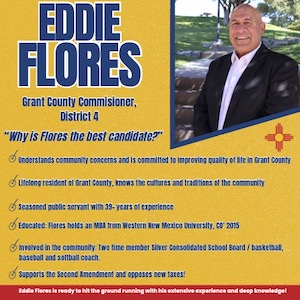At the Legislative Forum, Brian Bentley, Gila Regional Medical Center chief executive officer, told Sen. Howie Morales, Rep. Dianne Hamilton and Rep. Rodolpho "Rudy" Martinez that he would talk about the "viability of the emergency medical services."
"EMS services are dual- and triple-regulated," Bentley said. "It's becoming an increasing problem for small volunteer services."
There are in Grant County 15 emergency medical services, which are mainly volunteer-staffed. They have minimal money to meet regulations and fewer people are volunteering. Key people are retiring and no one is following to fill the positions.
"Regulations require an EMS to have two emergency medical technicians to run an ambulance," Bentley said. "Sapillo Creek VFD no longer has ambulance service, which requires a longer response time to get to patients."
Bentley pointed out that 55 percent of EMS systems in the state are made up of volunteers.
An EMT requires 76 hours of training up to a paramedic, which is college level.
"Volunteers cannot put in that number of hours, especially if they also hold a job," he said. "These small groups are having to move to a response team, who can start to help, but have to wait for an ambulance to do any treatment. The volunteers also have a higher continuing education load than most doctors. Burnout is also a problem. There are 400,000 emergency calls in New Mexico annually.
"Yes, you need two sets of hands for an emergency call, but they don't have to have the same level of training," Bentley continued. "If the regulations are loosened, we can increase the viability of ambulance services."
He also pointed out that most small ambulance agencies operate at a loss, and collection rates are only 58 percent.
"Many of the volunteers are old, their workload is too high, and the educational requirements are too high," Bentley said. "A number of solutions would help, including affordable local education opportunities, fewer regulations and incentives to take the training."
Morales asked if a memorial had been drafted. The response was that it had not.
Don McNutt, GRMC EMS director, said his opinions were the same as Bentley's, especially on loosening the requirements on education.
"I think having a first level EMT and a regular EMT in the back of the ambulance would be sufficient," McNutt said. "We're fortunate, but we would like to see the Public Regulation Commission loosen requirements. I would also like to see the oversight of the EMS under the Department of Health, instead of the PRC. They regulate trucks and cattle carriers, but we're a health-care service. In other states, the EMS is under Health."
Morales asked if the EMS is regulated through the PRC or by statute.
McNutt said he believed it was by statute.
Hamilton asked how liability is handled.
McNutt said, if the service is under the county, it is covered by the county. If it is under GRMC, the hospital carries the liability. "Lake Roberts is ours; the others are under the county. We have 45 people on our roll throughout the county."
Because of the education requirements, it is becoming hard to get retiring folks to volunteer.
"Firefighters have their own training, but if they become EMTs, the training is practically impossible for them. It's burdensome," McNutt said.
Hamilton said she sees no reason for EMS to be under the PRC. "It makes no sense."
Martinez said he has served as a volunteer firefighter and a first responder, and, having seen different situations, knows that burnout is a problem.
He said if a person volunteers for 10 years with a volunteer fire department, he or she will receive $100 a month retirement stipend, and for 25 years, $200 a month.
"That is a small incentive," Martinez said. "The situation is not getting better. Out-of-pocket expenses are also a problem. I understand the need for continuing education, but we need to figure out how to provide it more easily."
McNutt said his department has tried to increase funding for the educational components, but it's hard to recruit a 60-year-old because of out-of-pocket expenses that will hurt a family.
"An EMT course costs $1,000," McNutt said. "That's hard to pay for. The minimum is $3,000 to $5,000."
Martinez said he, because he used to be a first responder, could bridge to an EMT.
McNutt said the program was no longer available, and it requires 76 hours of education for a first responder. An intermediate EMT requires 200 hours.
"You can, however, bridge from paramedic to nurse," he said.
Morales said a move from technical to professional could give a person different options, and perhaps funding could be found.
"EMTS consider themselves professionals," McNutt said.














